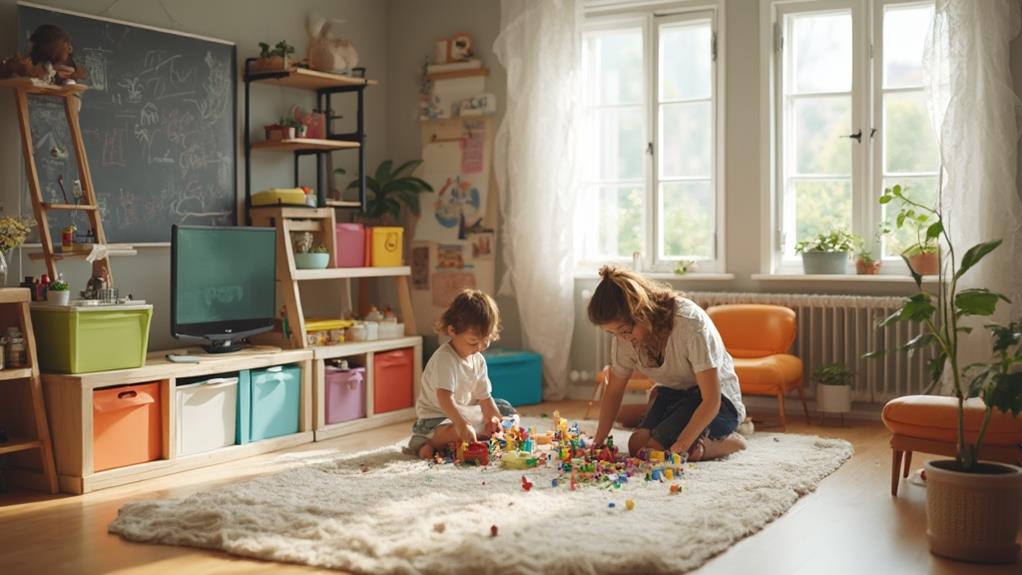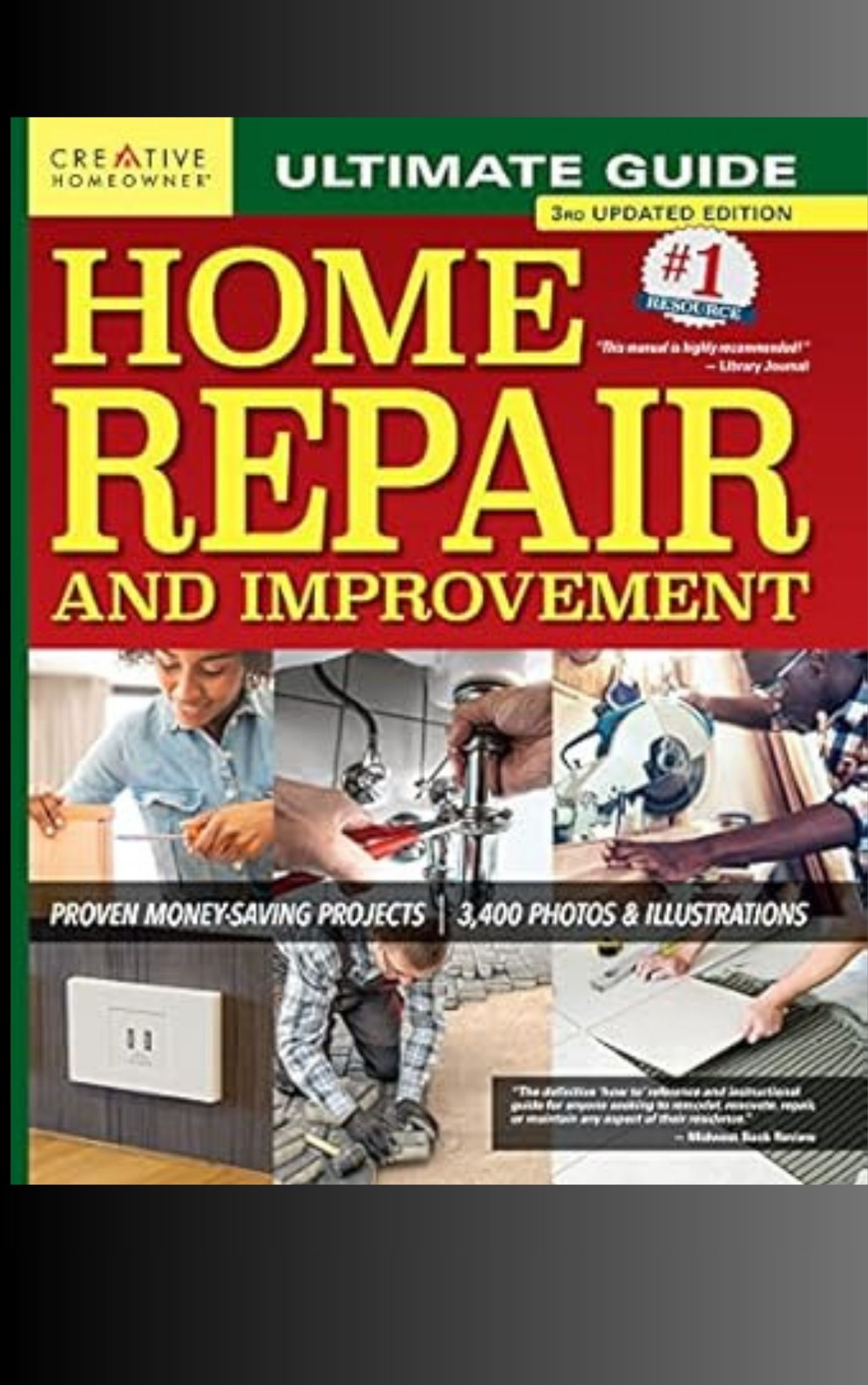
Family-friendly renovations focus on creating adaptable spaces that evolve with your children's needs. Key elements include modular furniture, expandable storage systems, and flexible room layouts. Convertible cribs, adjustable desks, and multifunctional pieces maximize space efficiency. Durable flooring options like luxury vinyl plank or porcelain tile withstand wear and tear. Tech-ready study areas with proper lighting and connectivity support learning at various stages. Adaptive playrooms with magnetic walls and movable storage encourage creativity. Thoughtful design choices in bedrooms, bathrooms, and outdoor spaces ensure longevity and functionality. By implementing these versatile solutions, families can create living environments that seamlessly transition through childhood and beyond.
Adaptive Playroom Design
Frequently, parents find themselves redesigning playrooms as their children grow and their needs change. An adaptive playroom design can alleviate this challenge by incorporating flexible elements that evolve with children's interests and developmental stages.
To create a versatile space, consider modular furniture and storage solutions that can be easily reconfigured or repurposed. Opt for adjustable shelving units and multi-functional pieces, such as tables with built-in storage or seating that doubles as toy chests. Install a magnetic or chalkboard wall to encourage creativity and provide a changeable display area. Choose durable, easy-to-clean flooring materials like cork or rubber tiles, which can withstand spills and rough play while offering comfort.
Lighting is crucial in an adaptive playroom. Install dimmer switches and task lighting to accommodate various activities, from active play to quiet reading. Consider a neutral color palette for walls and major fixtures, allowing for easy updates with colorful accessories or themed decor as children's preferences evolve. Finally, incorporate technology-ready spaces with strategically placed outlets and charging stations to support educational activities and entertainment as children grow older.
Multifunctional Furniture Solutions
In the realm of family-friendly renovations, multifunctional furniture solutions play a key role in maximizing space and adaptability. These versatile pieces serve multiple purposes, allowing rooms to evolve as children grow and family needs change.
Convertible cribs that transform into toddler beds and eventually full-sized beds are a prime example, providing long-term value and reducing the need for frequent furniture replacements.
Storage ottomans offer hidden compartments for toys while doubling as extra seating. Expandable dining tables accommodate both intimate family meals and larger gatherings. Murphy beds or wall beds free up floor space during the day, converting rooms into play areas or home offices. Modular shelving systems adapt to changing storage needs, from picture books to textbooks.
For shared bedrooms, bunk beds with built-in desks or storage drawers optimize vertical space. Nesting tables provide flexible surface areas for various activities. Foldable or stackable chairs allow for easy storage when not in use. By investing in these multifunctional pieces, families can create dynamic living spaces that efficiently meet their evolving requirements while maintaining a cohesive and stylish home environment.
Expandable Storage Systems
Expandable storage systems' versatility makes them indispensable for growing families. These adaptable solutions offer the flexibility to accommodate changing needs as children grow and family dynamics evolve. Modular shelving units, adjustable closet systems, and stackable storage containers are excellent options for maximizing space efficiency while maintaining organization.
Modular shelving systems allow for easy reconfiguration as storage needs change. Wall-mounted tracks with adjustable shelves and cubbies can be modified to store toys, books, or clothing as children transition from toddlers to teens.
Adjustable closet systems feature hanging rods, drawers, and shelves that can be raised, lowered, or repositioned to suit different age groups and storage requirements.
Stackable storage containers provide a cost-effective solution for managing clutter. These units can be easily added or removed as needed, making them ideal for playrooms, bedrooms, and shared spaces. Consider clear containers for easy identification of contents and color-coded options to designate ownership or categorize items.
Flexible Bedroom Layouts
Bedrooms transform into multifunctional spaces with flexible layouts designed to adapt to a family's changing needs. Incorporating versatile furniture and modular elements allows these rooms to evolve as children grow from infants to teenagers and beyond. Convertible cribs that transition into toddler beds and eventually full-sized beds provide long-term value and minimize the need for frequent furniture replacements.
Murphy beds or loft beds with integrated desks optimize floor space, creating room for play areas or study zones. Movable partitions or sliding doors can divide larger rooms into separate spaces for siblings, offering privacy when needed and the option to open up for shared activities. Built-in storage solutions, such as under-bed drawers or wall-mounted shelving units, maximize vertical space and keep the room clutter-free.
Neutral color schemes and timeless design elements ensure that the room's aesthetic remains appropriate throughout various life stages. Incorporating adaptable lighting fixtures, such as adjustable track lighting or dimmable overhead lights, accommodates changing visual needs for different activities. By prioritizing flexibility in bedroom layouts, families can create spaces that evolve seamlessly with their children's growth and changing preferences.
Tech-Ready Study Spaces
While flexible bedroom layouts accommodate various activities, modern homes must also provide dedicated areas for focused learning and work. Tech-ready study spaces are essential for children's academic success and parents' remote work needs. These areas should incorporate ergonomic furniture, ample lighting, and robust technological infrastructure.
Start by selecting a quiet location with minimal distractions. Install adjustable desks and chairs to accommodate growing children and promote proper posture. Incorporate task lighting and natural light sources to reduce eye strain during long study sessions. Ensure adequate power outlets and USB charging ports are available for various devices.
Invest in high-speed internet and Wi-Fi extenders to guarantee seamless connectivity throughout the space. Consider built-in storage solutions for organizing books, supplies, and electronics. Integrate smart home technology, such as voice-activated assistants and smart plugs, to enhance productivity and energy efficiency.
To future-proof the study area, plan for flexibility in layout and technology integration. Include modular furniture and easily upgradeable tech components to adapt to changing needs. By creating a well-designed, tech-ready study space, families can foster an environment conducive to learning and productivity for years to come.
Durable Flooring Options
Selecting durable flooring is crucial for family-friendly home renovations, as it must withstand heavy foot traffic, spills, and the wear and tear of daily life. Luxury vinyl plank (LVP) flooring offers an excellent balance of durability and aesthetic appeal. It's resistant to scratches, dents, and moisture, making it ideal for high-traffic areas and rooms prone to spills. LVP also comes in a variety of wood-look finishes, providing the warmth of hardwood without the maintenance concerns.
Another robust option is porcelain tile, known for its exceptional durability and water resistance. It's perfect for bathrooms, kitchens, and entryways, where moisture and dirt are common. Porcelain tiles are available in numerous styles, including wood and stone imitations, allowing for versatile design choices.
For a softer underfoot feel, consider low-pile carpeting with stain-resistant fibers. This option works well in bedrooms and living areas, providing comfort while still being relatively easy to clean. Alternatively, cork flooring offers natural cushioning and sound absorption properties, making it an eco-friendly and comfortable choice for family homes. Its ability to be refinished extends its lifespan, ensuring long-term durability.
Adjustable Lighting Schemes
Illumination plays a crucial role in creating a family-friendly home environment. Adjustable lighting schemes offer versatility and functionality for spaces that need to accommodate various activities and age groups. Implementing a combination of ambient, task, and accent lighting allows for customization based on time of day and specific needs.
Dimmer switches are essential for adjustable lighting, enabling parents to create a soothing atmosphere for bedtime routines or brighten spaces for homework and playtime. Smart lighting systems provide even more control, allowing for preset scenes and remote operation via smartphone apps. Consider installing motion-activated lights in hallways and bathrooms for nighttime safety.
Layer lighting sources to achieve optimal flexibility. Overhead fixtures can provide general illumination, while table lamps and floor lamps offer localized lighting for reading or crafts. LED strip lights under cabinets or along bookshelves add both functionality and ambiance. For children's rooms, incorporate fun, themed lighting fixtures that can be easily swapped out as interests change. Remember to use warm color temperatures in bedrooms and living areas to promote relaxation, while cooler tones in study areas can enhance focus and productivity.
Convertible Outdoor Play Areas
For families seeking to maximize their outdoor space, convertible play areas offer a versatile solution that adapts to changing needs and interests. These flexible designs allow homeowners to create multi-functional spaces that evolve as children grow, ensuring long-term value and enjoyment.
Key features of convertible outdoor play areas include modular equipment, adjustable components, and multi-purpose structures. Modular playsets can be reconfigured or expanded to accommodate different age groups and activities. Adjustable components, such as basketball hoops or climbing walls, can be raised or lowered to suit various skill levels. Multi-purpose structures, like covered pavilions, can serve as playhouses for young children and later transform into teen hangout spots or outdoor dining areas.
Incorporating durable, low-maintenance materials is crucial for longevity and easy upkeep. Consider weather-resistant synthetic turf for safe play surfaces, composite decking for sturdy platforms, and powder-coated metal for equipment durability. Strategic landscaping can define distinct zones while providing natural shade and privacy. By thoughtfully designing convertible outdoor play areas, families can create dynamic spaces that support children's development, encourage outdoor activities, and adapt to changing family dynamics over time.
Future-Proof Bathroom Renovations
When renovating bathrooms, homeowners should consider future-proofing their designs to accommodate changing needs and preferences over time. This approach ensures longevity and functionality as children grow and family dynamics evolve.
Start by installing adjustable-height sinks and mirrors, allowing easy access for children while they're young and adapting as they grow taller. Opt for slip-resistant flooring to enhance safety for all ages. Consider a curbless shower design, which not only creates a modern aesthetic but also improves accessibility for family members with mobility issues.
Choose durable, low-maintenance materials that can withstand wear and tear, such as porcelain tiles and quartz countertops. Install adequate storage solutions, including built-in cabinets and shelving, to accommodate changing needs over time. Incorporate a combination of task and ambient lighting to create a versatile space suitable for various activities.
Consider eco-friendly fixtures, such as dual-flush toilets and low-flow faucets, to promote water conservation and reduce utility costs. Finally, plan for potential future modifications by leaving space for grab bars or built-in seating, ensuring the bathroom remains functional and safe for years to come.
Frequently Asked Questions
How Can I Childproof My Home During Renovations?
To childproof your home during renovations, implement safety measures such as securing tools, covering exposed outlets, blocking off construction areas, and removing hazardous materials. Install temporary gates, use corner guards, and ensure proper ventilation to maintain a safe environment for children.
What's the Average Cost of a Family-Friendly Home Renovation?
Imagine a home transformation unfolding before your eyes. The average cost of a family-friendly renovation varies widely, typically ranging from $20,000 to $100,000, depending on the scope, materials, and location. Careful planning can optimize your budget effectively.
Are There Eco-Friendly Options for Kid-Centric Home Improvements?
Yes, numerous eco-friendly options exist for kid-centric home improvements. These include non-toxic, low-VOC paints, sustainable flooring materials like bamboo or cork, energy-efficient lighting, and water-saving fixtures. Recycled or upcycled furniture and decor are also environmentally conscious choices.
How Long Does a Typical Family-Focused Renovation Project Take to Complete?
Buckle up for a wild ride! Family-focused renovations can take anywhere from a blink-and-you'll-miss-it weekend to a seemingly endless six months. Typically, expect 4-8 weeks for moderate projects, depending on scope and complexity. Plan accordingly!
Can I Get Tax Benefits for Making My Home More Family-Friendly?
Tax benefits for family-friendly home improvements are limited. Generally, only energy-efficient upgrades or medical necessity modifications qualify for tax deductions. Consult a tax professional for specific advice on potential credits or deductions related to your renovations.
Conclusion
Family-friendly renovations transform houses into dynamic homes, evolving with children's needs. From adaptive playrooms to convertible outdoor spaces, these modifications foster growth, encourage imagination, and support learning. Multifunctional furniture, expandable storage, and flexible layouts maximize space efficiency. Tech-ready study areas and durable materials ensure longevity. By implementing these strategies, homeowners create environments that adapt, endure, and nurture. Ultimately, family-friendly renovations yield spaces that grow, change, and thrive alongside their young inhabitants.

